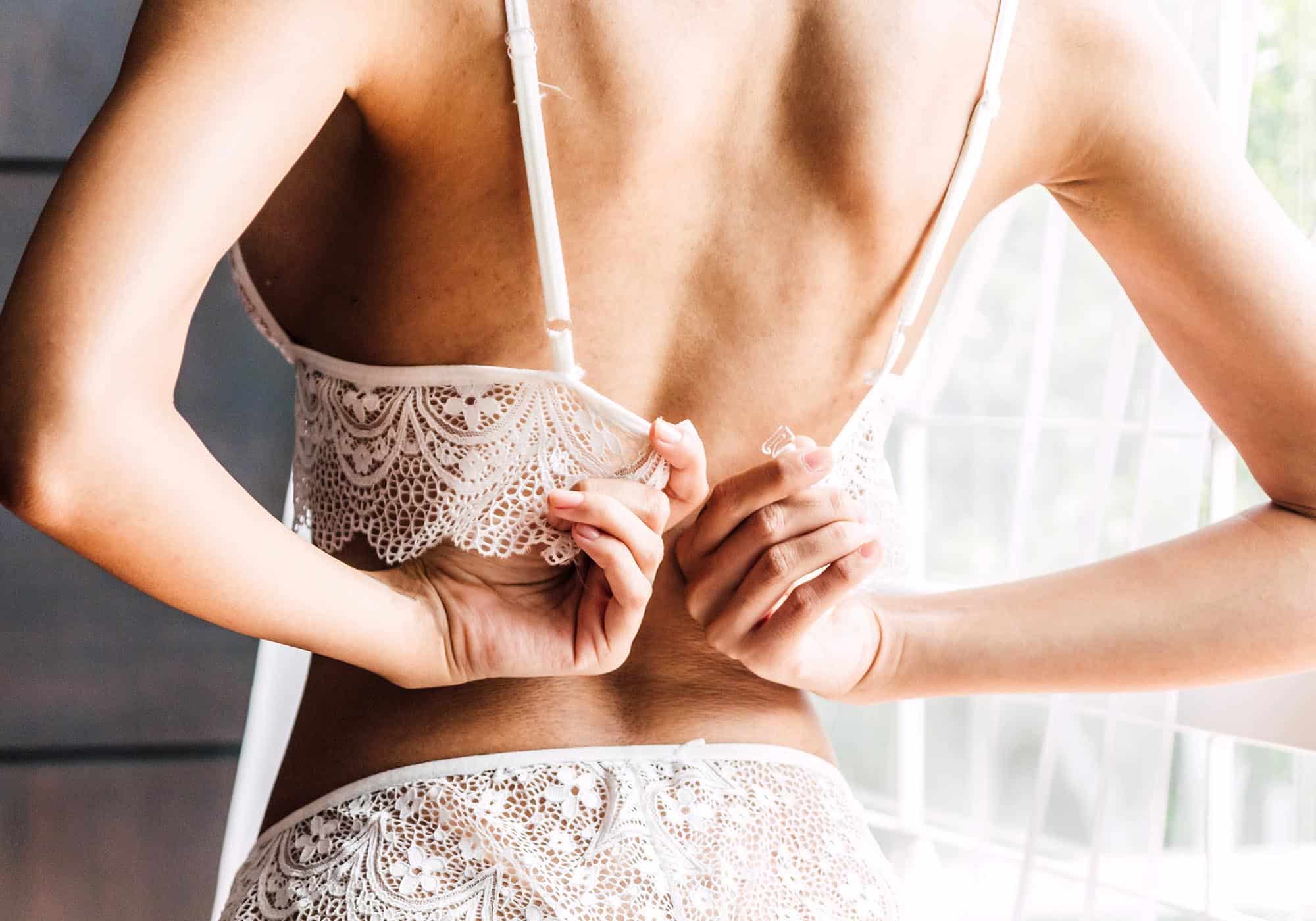We’re willing to wager that if we were to ask a sweeping sample of American women about their ultimate aesthetic goals, the majority would put “perky breasts” at the top of the list: year after year, augmentations, lifts, and other breast surgeries remain the most popular cosmetic procedures stateside. But what if one’s breasts aren’t perky—even after committing to surgery?
Full breasts, be they natural or surgeon-made, can have a bit of heft to them. According to Dr. Kelly Killeen, a board-certified plastic surgeon in Beverly Hills, California, implants can weigh anywhere from a quarter of a pound to a pound and three-quarters, while natural breasts can weigh as much as 10 pounds or more each, depending on the individual. Over time, the skin there can thin, due to the effects of gravity, and would benefit from extra help in supporting the weight of an implant or breast tissue—you know, like a bra. Internal bra surgery does just that.
“An internal bra is a material placed to support either breast tissue or a breast implant, to help give longevity to results and prevent complications,” explains Dr. Jerry Chidester, a board-certified plastic surgeon in Draper, Utah, who performs hundreds of internal bra procedures annually. While some internal bras consist of sutures made by a surgeon, many are special pieces of dissolvable mesh designed for this use. One such example is GalaFlex, a bioabsorbable mesh made of poly-4-hydroxybutyrate, a type of polymer. This mesh is secured along the ribs in order to help support the breast. A few weeks post-op, your body starts developing tissue around the mesh, creating natural reinforcements to inevitably replace the internal bra. “Over a period of about 18 to 24 months, [the mesh] creates fibroblasts, converting to type three and type one collagen,” says Dr. Chidester. Once two years have passed, the body has fully absorbed the mesh and developed collagen where the mesh once was, resulting in a durable, natural support system.
At Dr. Chidester’s practice, an estimated 75% of internal bra surgery is incorporated into augmentations, with the other 25% supporting natural breasts after a lift or a reduction. For someone seeking support after those latter surgeries, the use of an internal bra is fairly straightforward: “With a natural breast, the internal bra will help keep the breast in its new location following surgery … [with] less stretching of the skin, which prevents breast tissue sagging,” notes Dr. Killeen.
When it comes to augmented breasts, an internal bra can address a broad range of concerns. “A lot of patients come in wanting a very rounded upper look, even without a bra,” says Dr. Chidester. “Someone who has a lot of stretch marks on their breasts, if they’ve breastfed, if they have thin skin—they don’t have a good support structure for a full upper look. I tell people, it’s like a bowling ball in a stocking.” In these circumstances, an internal bra will go a long way toward protecting the patient’s skin and their surgical investment.
Additionally, internal bras can be helpful for breast augmentation patients who are unhappy with the outcome of their original surgery. One of the most common complications that could call for an internal bra is an issue with a patient’s implant pocket(s). “The implant pocket is the space made to house the implant, with the proper placement centered under the nipple with equal projection on each side, lateral and medial,” says Dr. Killeen. Though the implant pocket itself will vary, depending on the chosen style of implant, “the pocket should fit the implant precisely and not allow too much movement,” she adds.
However, implants can migrate within the pocket. In the past, selecting a textured implant reduced the risk of implant migration, since the rougher finish of the implant’s surface (as opposed to a traditional smooth implant) helped keep it in the right place. But no longer: “Most surgeons do not use these implants, due to the risk of BIA-ALCL,” explains Dr. Killeen. Now the use of internal bras can help resolve migration concerns.
A frequent implant-pocket issue is what plastic surgeons refer to as “bottoming out.” The heavier the implant and the thinner the skin, the more likely it is that a breast implant will drop lower than the inframammary fold—often, where the surgical incision was made. The scar then rides up over the implant, causing a secondary concern. “We call it ‘stargazing’—as the implant drops, the nipple starts looking up to the stars,” says Dr. Chidester. This can occur even if a patient opts for submuscular implants, because the chest’s pectoralis major muscle doesn’t cover the lower part of the breast, which minimizes support.
Alternatively, an implant can shift laterally within its pocket, widening the gap between the two breasts. Capsular contracture can also necessitate an internal bra. When you get breast implants, scar tissue grows around them, holding them in place; in some situations, however, the scar tissue becomes overly firm, warping the appearance of the breast. “In [all these] situations, the internal bra will control the muscle, reduce recurrence of the contracture, and secure the implant position, respectively,” says Dr. Killeen.
When incorporating an internal bra into breast augmentation revision cases, Dr. Chidester uses the old scar—ideally, in the inframammary crease—to open up the implant pocket. “I’ll typically tighten the capsule first with a capsulorrhaphy, because you want to get that pocket to the size and location you want,” he says. “Then the internal bra is anchored to the periosteum, or rib lining, at the new level where we want the bottom of the implant to sit.”
The use of internal bras isn’t limited to correcting complications or supporting surgically revised natural breasts. Internal bras have increased in popularity so much, patients now ask that they be added to primary breast augmentation surgery because of the coveted “boosted” look. Dr. Chidester offers his own unique combo procedure that incorporates breast augmentation, the internal bra, and fat grafting, which he says can create “monstrous cleavage,” if that’s the patient’s goal.
Like any surgical procedure, internal bras come with risks, though Dr. Chidester notes that complications like bleeding or infections are quite uncommon (so uncommon, in fact, that he’s never seen them firsthand). The most important consideration with internal bras tends to be who performs the procedure. “There are a lot of technical aspects—it’s very powerful,” he says. Even small tweaks, like setting one breast slightly higher than the other, will be highly visible, so finding a board-certified plastic surgeon with a great deal of experience performing internal bra surgery is vital to achieving optimal results. Otherwise, recovery is typically smooth, with a few days of pain (like with any other breast surgery) and occasional intermittent discomfort from the sutures of the internal bra as the patient heals. That tends to resolve by the six-week mark, which is when Dr. Chidester allows his patients to resume heavy lifting and other related activities.
It’s important to remember that while an internal bra can make your breasts appear perky 24/7, this surgical enhancement is by no means a replacement for a regular bra. Dr. Chidester likens it to orthodontia—if you’ve ever had braces, you know that you should be wearing a retainer every night in order to maintain your results. “At night, you should have external support, like a sports bra or a supportive camisole,” he says. Dr. Killeen agrees. “You can control the effect of gravity on your breasts,” she reminds us. “It’s like wearing a belt and suspenders—please wear a bra and protect your investment.”











